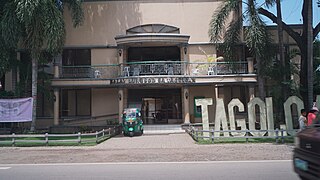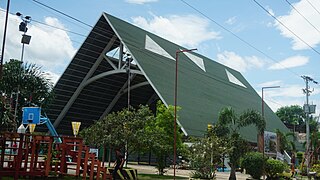
Northern Mindanao is an administrative region in the Philippines, designated as Region X. It comprises five provinces: Bukidnon, Camiguin, Misamis Occidental, Misamis Oriental, and Lanao del Norte, and two cities classified as highly urbanized, all occupying the north-central part of Mindanao island, and the island-province of Camiguin. The regional center is Cagayan de Oro. Lanao del Norte was transferred to Northern Mindanao from Region XII by virtue of Executive Order No. 36 in September 2001.

Misamis Occidental is a province located in the region of Northern Mindanao in the Philippines. Its capital is the city of Oroquieta. The province borders Zamboanga del Norte and Zamboanga del Sur to the west and is separated from Lanao del Norte by Panguil Bay to the south and Iligan Bay to the east. The province of Misamis was originally inhabited by Subanens who were an easy target by the sea pirates from Lanao.

Misamis Oriental is a province located in the region of Northern Mindanao in the Philippines. Its capital and provincial center is the city of Cagayan de Oro, which is governed independently from the province. There is a move lately to transfer the provincial capital to the municipality of Laguindingan where the airport is now located.

Iligan, officially the City of Iligan or referred to as Iligan City, is a 1st class highly urbanized city in Northern Mindanao, Philippines. According to the 2015 census, it has a population of 342,618 people.

Oroquieta, officially the City of Oroquieta,, or simply referred to as Oroquieta City, is a 4th class city and capital of the province of Misamis Occidental, Philippines. According to the 2015 census, it has a population of 70,757 people.

Alubijid, officially the Municipality of Alubijid, is a 4th class municipality in the province of Misamis Oriental, Philippines. According to the 2015 census, it has a population of 29,724 people.

Binuangan, officially the Municipality of Binuangan, is a 6th class municipality in the province of Misamis Oriental, Philippines. According to the 2015 census, it has a population of 7,515 people.

Balingoan, officially the Municipality of Balingoan, is a 5th class municipality in the province of Misamis Oriental, Philippines. According to the 2015 census, it has a population of 11,051 people.

El Salvador, officially the City of El Salvador,, or simply referred to as El Salvador City is a 6th class city in the province of Misamis Oriental, Philippines. According to the 2015 census, it has a population of 50,204 people.

Initao, officially the Municipality of Initao, is a 3rd class municipality in the province of Misamis Oriental, Philippines. According to the 2015 census, it has a population of 32,370 people.

Laguindingan, officially the Municipality of Laguindingan, is a 4th class municipality in the province of Misamis Oriental, Philippines. According to the 2015 census, it has a population of 24,405 people.

Libertad, officially the Municipality of Libertad, is a 5th class municipality in the province of Misamis Oriental, Philippines. According to the 2015 census, it has a population of 12,354 people.

Manticao, officially the Municipality of Manticao, is a 4th class municipality in the province of Misamis Oriental, Philippines. According to the 2015 census, it has a population of 28,422 people.

Naawan, officially the Municipality of Naawan, is a 4th class municipality in the province of Misamis Oriental, Philippines. According to the 2015 census, it has a population of 21,213 people.

Opol, officially the Municipality of Opol, is a 2nd class municipality in the province of Misamis Oriental, Philippines. According to the 2015 census, it has a population of 61,503 people.

Salay, officially the Municipality of Salay, is a 4th class municipality in the province of Misamis Oriental, Philippines. According to the 2015 census, it has a population of 28,705 people. The town is known for its handmade paper and papercrafts, similar to washi, but made with indigenous fibers.

Tagoloan, officially the Municipality of Tagoloan, is a 1st class municipality in the province of Misamis Oriental, Philippines. It is located to the east of Cagayan de Oro City and located south-east of the Macajalar Bay. According to the 2015 census, it has a population of 73,150 people.

Villanueva, officially the Municipality of Villanueva, is a 2nd class municipality in the province of Misamis Oriental, Philippines. According to the 2015 census, it has a population of 39,378 people.

Metropolitan Cagayan de Oro, also known as Metro Cagayan de Oro, is the fourth largest metropolitan area in the Philippines. It is located on the northern coast of Mindanao, and comprises the two chartered cities of Cagayan de Oro and El Salvador and the eleven municipalities of Alubijid, Claveria, Gitagum, Initao, Jasaan, Laguindingan, Libertad, Manolo Fortich, Opol, Tagoloan, and Villanueva. According to the 2015 Philippine census, Metro Cagayan de Oro has a population of 1,376,363 people.

Cagayan de Oro, officially the City of Cagayan de Oro or simply referred to as CDO, is a 1st class highly urbanized city in Northern Mindanao, Philippines. It is the capital of the province of Misamis Oriental where it is geographically situated but governed administratively independent from it. According to the 2015 census, it has a population of 675,950 people.






















